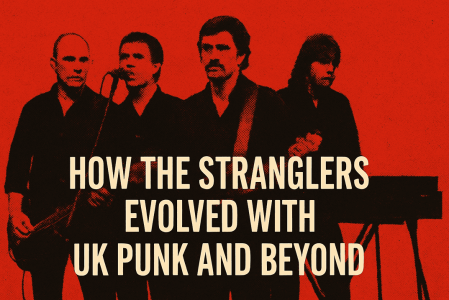The Stranglers formed in Guildford, Surrey, in 1974. Their early sound blended raw rock with hints of jazz and psychedelia, built on dark basslines and swirling keyboards. Unlike many punk bands that followed, The Stranglers had musical training and a few years of gigging behind them before the punk scene exploded.
When UK punk took off in 1976, The Stranglers were already on the rise. Though older and more musically complex than their punk peers, they were swept into the movement’s momentum. Their aggression, anti-establishment lyrics, and stripped-down energy made them fit the punk label—whether they wanted it or not.
Pre-Punk Foundations (Early 1970s)
The Stranglers began as The Guildford Stranglers in the early 1970s. Founding members—Jet Black, a jazz drummer, and Hugh Cornwell, a biochemistry graduate—brought unusual depth to the band’s sound. Jean-Jacques Burnel’s classical guitar background added a distinct edge, while Dave Greenfield’s keyboards would later become a signature element.
Their early music didn’t yet fit the punk mold. It leaned into blues-rock, psychedelia, and even progressive influences. But it was tight, raw, and charged with tension. This made them a natural fit for the pub rock circuit, a scene known for its gritty venues and no-nonsense performances. Like Dr. Feelgood and Eddie and the Hot Rods, The Stranglers helped bridge the gap between classic rock and what would become punk—angry, urgent, and stripped of excess.
Punk Emergence and The Stranglers’ Entry (1976–1977)
By 1976, the UK punk scene was breaking wide open. The Stranglers, though older and more musically skilled than many of their peers, became part of the first wave. Their aggressive stage presence, dark lyrics, and snarling attitude matched the mood of the time—even if they didn’t dress the part.
Their debut album, Rattus Norvegicus (1977), hit hard. Tracks like “Peaches” and “(Get A) Grip (On Yourself)” mixed sneering vocals with driving bass and swirling keyboards, setting them apart from the guitar-led punk sound. Just months later, No More Heroes followed, with its title track becoming a punk anthem in its own right.
The Stranglers often shared bills with The Clash and the Sex Pistols, but the relationship was tense. They weren’t fully embraced by the punk inner circle, seen by some as opportunists or outsiders. The media echoed this view, painting them as misfits—too slick, too rude, or simply too different. But that distance only sharpened their identity, pushing them to carve out their own place in the chaos.
Divergence from Punk Orthodoxy (Late 1970s–Early 1980s)
As punk began to settle into its own rules, The Stranglers moved in the opposite direction. While many punk bands stuck to a raw, guitar-heavy sound, The Stranglers leaned further into keyboards and layered arrangements. Dave Greenfield’s swirling, baroque-style synth lines became central to their music, giving tracks a strange, haunting depth that punk rarely touched.
Lyrically, they veered from punk’s political rallying cries. Instead, their songs dealt in cynicism, misanthropy, and taboo. Tracks like “Nice ’n’ Sleazy” and “Dead Ringer” were provocative by design—challenging listeners rather than uniting them around a cause.
This shift split opinion. Punk purists accused them of straying too far, of being too polished or too weird. But broader audiences took notice. Their willingness to evolve kept them charting and helped them outlast many of their peers. They didn’t abandon punk—they redefined what it could be.
Post-Punk Transition and Evolution (1980s)
In the 1980s, The Stranglers shifted again—this time into darker, more melodic territory. As the raw energy of punk faded, they embraced elements of new wave and gothic rock. The snarling edge remained, but the mood deepened, with more atmosphere and nuance in their sound.
The Raven (1979) marked the turning point. It pushed beyond punk with ambitious themes and textured production. By the time La Folie arrived in 1981, the transformation was clear. Songs like “Golden Brown” paired harpsichord lines with cryptic lyrics, earning both mainstream success and critical respect.
Line-up changes also shaped this era. As the decade progressed, internal tensions rose. Hugh Cornwell’s departure in 1990 ended a key chapter. But the band pressed on, adapting with new members and continuing to explore. Their evolution wasn’t just survival—it was a refusal to be boxed in by one scene or sound.
Closing Thoughts
The Stranglers took an unconventional path through the UK punk scene. They entered as outsiders—older, more skilled, and harder to pin down—and carved out a space that defied easy labels. While others stuck to punk’s raw template, The Stranglers pushed its limits with keyboards, complex arrangements, and provocative lyrics.
Their evolution into post-punk and beyond showed a band willing to change without losing its edge. Decades later, that adaptability still sets them apart. They weren’t just part of punk history—they helped shape what came after. Their legacy is one of defiance, not just against the system, but against musical expectations themselves.
